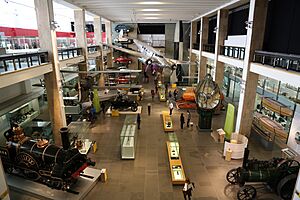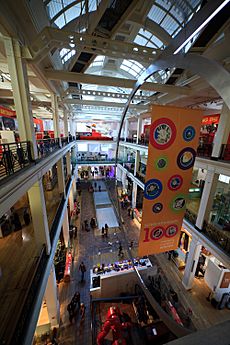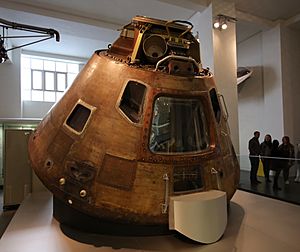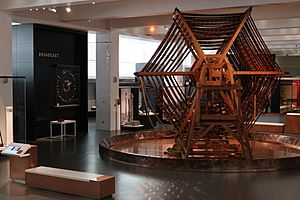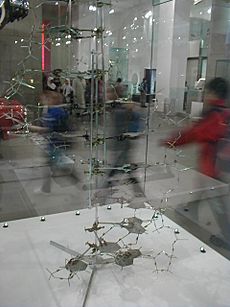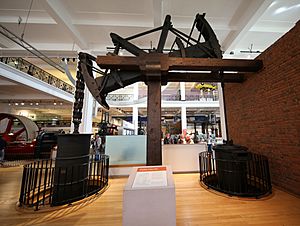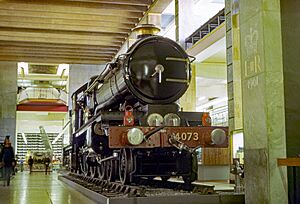Science Museum, London facts for kids
 |
|

The Science Museum
|
|
| Lua error in Module:Location_map at line 420: attempt to index field 'wikibase' (a nil value). | |
| Established |
|
|---|---|
| Location |
|
| Visitors | 2,827,242 (2024) |
| Public transit access |
|
| National Museum of Science and Industry | |
| National Media Museum · National Railway Museum (Shildon Locomotion Museum) · Science Museum (Dana Centre, Science Museum Swindon) | |
The Science Museum in London is a super cool place to explore science and technology! It's located on Exhibition Road in South Kensington and first opened its doors in 1857. It's one of London's most popular spots, with millions of visitors each year.
Good news! You don't have to pay to get into the main museum. Like other national museums in the UK, it's free to visit. Sometimes, special temporary exhibitions might have a small fee. The Science Museum is also part of a bigger group called the Science Museum Group.
Contents
Discovering the Museum's History
The Science Museum started way back in 1857. It began with collections from the Royal Society of Arts and items left over from the Great Exhibition. At first, it was part of a larger place called the South Kensington Museum, which also included what is now the Victoria and Albert Museum.
In 1885, the science parts of the collection officially became known as the Science Museum. Then, in 1909, it became its own independent museum. The buildings you see today were opened in different stages between 1919 and 1928. Over the years, the museum has grown a lot, adding new sections and interactive exhibits for everyone to enjoy.
Amazing Galleries to Explore
The Science Museum has two main parts: the main building and the Wellcome Wing. You enter the main building from Exhibition Road. To get to the Wellcome Wing, you walk through some awesome galleries on the ground floor.
Main Building – Level 0
The Energy Hall
The Energy Hall is often the first thing visitors see. It's packed with different steam engines that show how the British Industrial Revolution changed the world. You can even see the oldest surviving steam engine made by James Watt! There's also a cool recreation of James Watt's workshop.
Exploring Space
Exploring Space takes you on a journey through human space exploration. You'll see rockets and exhibits that tell the story of how we've explored space. It also shows how space technology helps us in our daily lives, especially with things like phones and TV.
Making the Modern World
This gallery features some of the museum's most famous items. You can see Puffing Billy, one of the oldest steam locomotives. There's also a model of Crick's double helix, which is the shape of DNA. A real command module from the Apollo 10 mission, which orbited the Moon, is also on display. You can also see a V-2 rocket, which was an important step in rocket technology. Did you know Stephenson's Rocket used to be here? It's now at the National Railway Museum in York!
Main Building – Level 1
Medicine: The Wellcome Galleries
These huge galleries explore the history of medicine from ancient times to today. With over 3000 exhibits and special artworks, you'll learn all about how we've understood and treated illnesses. Many items come from the amazing collection of Henry Wellcome.
Main Building – Level 2
The Clockmakers Museum
Step into the world's oldest clock and watch museum! This collection was first put together by the Worshipful Company of Clockmakers. You'll see incredible timepieces from different eras.
Science City 1550–1800: The Linbury Gallery
This gallery shows how London became a major center for trade, business, and scientific discovery between 1550 and 1800. It's like a time machine to a bustling scientific past!
Mathematics: The Winton Gallery
Discover how mathematicians have shaped our modern world in this gallery. You can even see a working example of Charles Babbage's Difference engine No.2. This amazing machine was built by the Science Museum!
Information Age
The Information Age gallery explores how communication and computing have changed over the last 200 years. It looks at six big networks that transformed how we connect, like the telephone, broadcasting, and the internet. The Queen even sent her first tweet from here when it opened in 2014!
Main Building – Level 3
Wonderlab: The Equinor Gallery
This is one of the most popular galleries! Wonderlab is super interactive, with lots of hands-on exhibits. Friendly Explainers are there to show you how things work, do live experiments, and put on cool science shows.
Flight
The Flight gallery tells the story of how flying developed in the 20th century. You'll see real aeroplanes and helicopters, including the Vickers Vimy that Alcock and Brown flew across the Atlantic in 1919. There are also Spitfire and Hurricane fighter planes, plus many engines.
Wellcome Wing
Power Up (Level 1)
Power Up is an awesome interactive gaming gallery. You can play on over 150 different consoles, from old ones like the Binatone TV Master to the latest PlayStation 5. It's a fun way to see the history of video games!
Tomorrow's World (Level 0)
This gallery features current science stories and free exhibitions. It's where you can learn about the latest discoveries and challenges in science.
IMAX: The Ronson Theatre (Entrance from Level 0)
Catch an amazing film at the IMAX: The Ronson Theatre. This cinema shows educational films, many in 3-D, as well as big movies and live events. The screen is huge, measuring 24.3 by 16.8 meters!
Who Am I? (Level 1)
In the Who Am I? gallery, you can explore the science behind what makes you, well, you! It uses interesting objects, thought-provoking art, and hands-on exhibits to help you understand yourself better.
Energy Revolution: The Adani Green Energy Gallery (Level 2)
This gallery looks at how the world can create and use energy in a more sustainable way. It explores how we can reduce carbon dioxide and fight climate change.
Special Exhibitions and Events
The museum often has temporary exhibitions, some free and some paid. These exhibitions cover all sorts of exciting topics and sometimes travel to other museums too.
Astronights for Children
Imagine sleeping in a museum! The Science Museum hosts Astronights for children aged 7 to 11. Kids get to do fun science activities all evening and then sleep among the exhibits. In the morning, there's breakfast and more science shows!
Lates for Adults
Once a month, the museum opens its doors for "Lates," which are special evenings just for adults. There are up to 30 different events, from talks to silent discos. It's a popular event for people under 35.
Past Galleries
The Science Museum has changed a lot over the years. Many old galleries have been replaced by new, exciting ones. For example, the Children's Gallery (1931–1995) was replaced by The Garden for younger kids. The Land Transport gallery (1967–1996) made way for the Making the Modern World gallery. The popular Launchpad gallery (1986–2015) was replaced by Wonderlab in 2016.
The Secret Life of the Home gallery, which showed how household appliances developed, closed in June 2024.
Museum Resources
The Science Museum has a special library and archives. It used to be Britain's national library for science, medicine, and technology. Today, the Dana Research Centre and Library is open to researchers and the public. You can access thousands of books there for free.
Directors of the Science Museum
Many people have led the Science Museum over the years. Here are some of the directors:
- Major-General Edward R. Festing CB FRS (1893–1904)
- William I. Last (1904–1911)
- Sir Francis Grant Ogilvie CB (1911–1920)
- Colonel Sir Henry Lyons FRS (1920–1933)
- Colonel E. E. B. Mackintosh DSO (1933–1945)
- Herman Shaw (1945–1950)
- F. Sherwood Taylor (1950–1956)
- Sir Terence Morrison-Scott DSc FMA (1956–1960)
- Sir David Follett FMA (1960–1973)
- Dame Margaret Weston DBE FMA (1973–1986)
- Neil Cossons OBE FSA FMA (1986–2000)
- Lindsay Sharp (2000–2002)
Since 2002, the Science Museum has been part of the larger Science Museum Group. The current director of the group is Ian Blatchford, who started in 2010.
See also
 In Spanish: Museo de Ciencias de Londres para niños
In Spanish: Museo de Ciencias de Londres para niños


